Artists' Writing
Artists' Writing

Lilith, Losing, Lavender
Lilith, Losing, Lavender: A love letter to love, is a publication based on stretching the subjectivities in love from the formulation I love You, as a way of seeing what is under the gaze of western romantic ideas and heteropatriarchal structures that may reveal problems in language about love.
It gathers a collection of texts written throughout the artistic research trajectory of Andrea Zavala Folache. With different narrative styles as diary, love letters, score instructions, this collection imbricates ideas of love, art and life as an essay about conditions of attachment.
In the interstice of several practices as dance, writing and drawing and different spaces as the dance studio, the atelier, the classroom, the theatre and the white cube, Andrea’s research focuses on non chronological dramaturgies for the emergence of surprise or unexpectedness.
Published 2021.
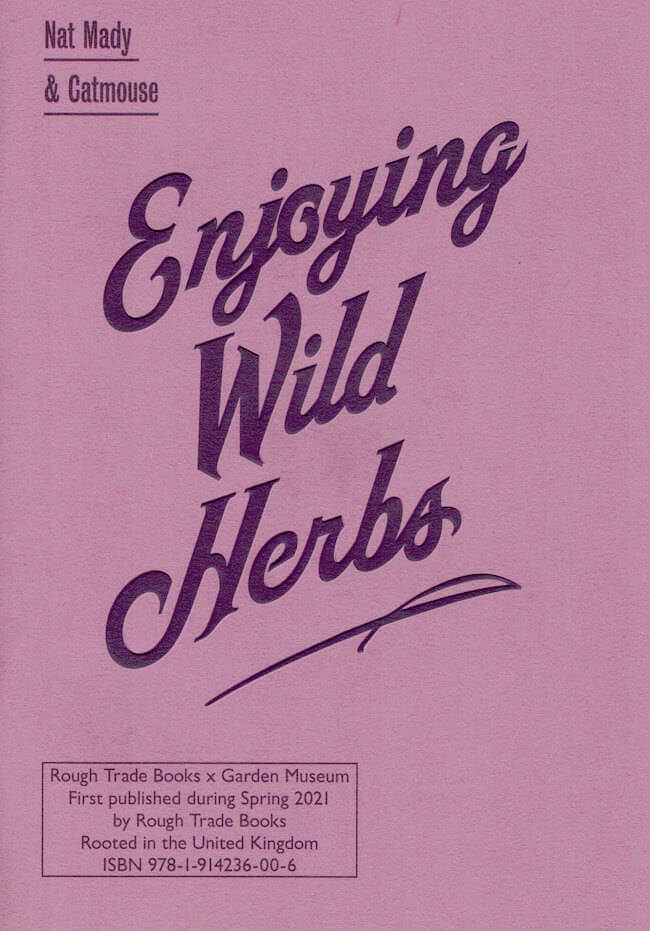
Enjoying Wild Herbs: a seasonal guide
Enjoying Wild Herbs: A Seasonal Guide brings Hackney Herbal’s Nat Mady and illustrator Catmouse together to introduce the wonderful world of herbs. Asking important questions about the nature of public and private space, of how we live alongside plants, how we use them, how we gather them, this is a treatise on how foraging and the knowledge that underpins it can be a radical act—an act that informs much of our attitude to the natural world, to the food we eat and to how we value the multitudinous life that surrounds us.
Published Spring 2021.

Sisters of the Wind
Sisters of the Wind is the fruit of artistic research on witches, ecofeminism, and science-fiction carried out between 2018 and 2021 by Juliette Lizotte aka jujulove. It is a story that weaves through seven videos and can be experienced in different ways: an interactive audiovisual performance, an online world-building workshop and role play session, and this publication!
The publication concludes the three world-building workshops and role play sessions part of the project which took place online in February 2021 due to the COVID-19 pandemic, though they were originally intended to unfold in the form of live action role play (larp). This new constraint led us to perform the worldbuilding and role play exercises in an etherpad, an open source digital tool for co-writing text in real-time. The outcome of these sessions was archived and used as material for the publication.
This "choose-your-own adventure" story consists of three parallel worlds that were co-created during three sessions, each lasting three hours. The core of the story was similar, but the direction the sessions took were quite unique. As the story unfolds, you are asked to make decisions to travel from one world to another: creating your own version of the story by following your instinct or challenging your impulses!
Sisters.°·
The wind is returning, as it always does. Sometimes it blows so hard that it carries artifacts away from the cities it tore apart, seeds from far away places, trees that didn’t have enough time to grow stronger... That’s why you always seek a protected area to settle in, relocating as the wind comes and goes in waves. You are witches. You pay attention to the world and try to make sense of this life together through the phases of the moon from maiden to mother to crone. In your community, the feminine spirit dominates, and all gender expressions are celebrated. When your precarious life is threatened by an unsettling prophecy announcing a deadly wind that will prepare the earth for a new cycle, will you go on a journey to find the source of this wind? What will you discover on the way? How will this transform you, your sisters, and the earth forever?
Edition of 100 published by Office of Metaphors, printed in Riso in May 2021 in Amsterdam.

I am Welton Santos.
I am Welton Santos reenacts a dialogue between the Brazilian geo-bio-architect Welton Santos and an Interviewer. The book, which is always read collectively, is used in reading performances by groups of at least 3 people.
Printed on the occasion of an artist residency at PAV, Parco d’Arte Vivente, Turin, July 2016. Texts based on transcripts of interviews with Welton Santos.

The Posttraumatic Newspaper vol.1 Inhale, Exhale
The Posttraumatic is a newspaper created by creatives and artists. [eng, cast, cat]
Why a newspaper? The project believes that a newspaper is an important link between our social reality (built over the centuries by three-headed monsters and the occasional fairy godmother) and the individuals who live in it, because it is an essential communication element and because its content is a fucking drama almost always.
When Ulrich Beck, a literate man, assures us that “the media does not respond to the inspiration of the enlightenment but to that of the market and capital” we can only read the news with a distrustful and defenseless frown. Uncle Sam manipulates us to his likings and we satisfy our appetites by feasting on his words as if they were cocaine-coated cookies that only serve to fatten the need to win over arguments at our neighbor’s dinner-table conversations. We do not know if the information we swallow is invented, bought, if they are news clippings curated by a 4channer´s paranoid imagination, or if it is an objective, absolute, eternal truth.
Based on these fatalistic, dramatic and somewhat depressing theories on news and their consumption, 39 artists were contacted and each one was granted with a space, a sort of an article, to do whatever they wanted with it. It has not been intended to generate any specific ideological discourse and there is no gift flag.
With Contributions by: Escif, Ampparito, Aida Gómez, Mas Siedentop, Jofre Oliveras, Flavita Banana, Helen Bur, Michael Beitz, Biancoshock, Milu Correch, Luce, Marta Aguilar, Jan Vorman, Igor Ponosov, Ana Vilamú, Vas Ban Wieringen, Gigi Ei, Vlady, Val Rovatti, Octavi Serra, Nicolás Garcia, Valentina and the Electic Post and Others.
Published 2021

touch me with your gloves i am not ready yet
Self-published poetry collection by Loïs Soleil. “Touch me with gloves, I am not ready yet” is the artist’s first poetry chapbook. It touches on subjects such as mothers, friendship breakups, surviving trauma, mental health and fuckboys.
Loïs Soleil is a Franco-Scottish artist inspired by intersectional feminism, net.art, pop culture and cultural studies. Her performances, installations and poems reveal an autobiographical directness, rawness and an emotionally vulnerable quality singular to their "hyper intimacy".
Comes in four colors: green, orange, blue and yellow.
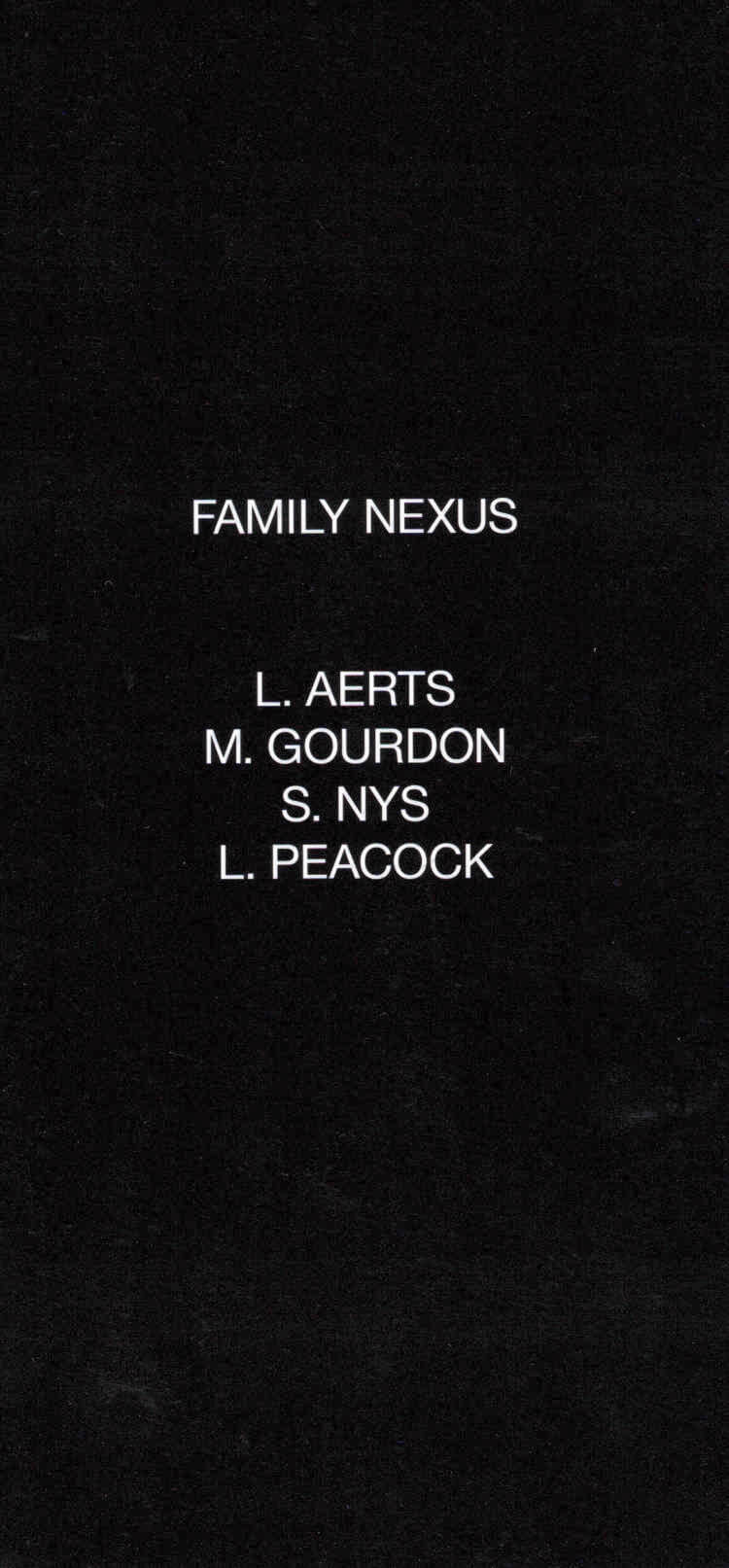
Family Nexus
Sophie Nys, Liene Aerts and 2 more
In April 2019, Sophie Nys presented the solo exhibition Family Nexus at KIOSK. In psychology, a family nexus stands for a vision that is shared by the majority of family members, often unconsciously and for several generations long, and is upheld in the context of events both within the family and in its relationship to the world. Among other, the monumental, stretched out net in the dome space was a symbol of this family dynamic.
Two years later, the theme is still working its way through the above mentioned heads. The shared interest of Nys, Gourdon, Aerts and Peacock leads to a collaboration in the form of a book that, just like the exhibition, can be read as a net of (un)coherent intrigues and knots in which no position can be neutral. They set up a network of characters. Together they represent all kinds of (human) connections. Family Nexus is a story about everyone and no one in particular. Who in this book is playing the role of the Nobody, the household’s so-called 'identified patient', or scapegoat, and which pots and pans has slipped through this character’s fingers?
Co-production: KIOSK and BOEKS.

Diagrammatic Writing
Diagrammatic Writing is a poetic demonstration of the capacity of format to produce meaning. The articulation of the codex, as a space of semantically generative relations, has rarely (if ever) been subject to so highly focused and detailed a study. The text and graphical presentation are fully integrated, co-dependent, and mutually self-reflexive.
This small book work should be of interest to writers, bibliographers, designers, conceptual artists, and anyone interested in the meta-language of diagrammatic thought in graphic form.
Special thanks to Iman Salehian for cover designs.
Thanks also to the Banff Art Centre, February 12-18, 2013.
Johanna Drucker is a writer and book artist known for her work in experimental typography. She has published and lectured widely on topics related to the history of the book, contemporary art, graphic design, and digital aesthetics. She is the Breslauer Professor of Bibliographical Studies in the Information Studies Department at the University of California, Los Angeles. Drucker wrote this text during residence at the Banff Art Centre, February 12-18, 2013.

Elizabeth in the Woolds
Elizabeth in the Woolds is the product of two superimposed compositional strategies; a thematic aggregate based on notes dating back to 2008 and an epic prose narrative. Elizabeth is the device through which this simultaneous register moves. Screen writing provides a model for multiple voices. In a film script, the narrator can be the camera; there’s a machine at the centre of the story structure which figures a demand for resolution of plot; a contrario, the thematic approach (S, U, N, as electric light) obliterates chronology, and enumerates an atemporal topological figure, or the way the world is built.
(730pp., self-published first edition of 50, Kortrijk, 2021)
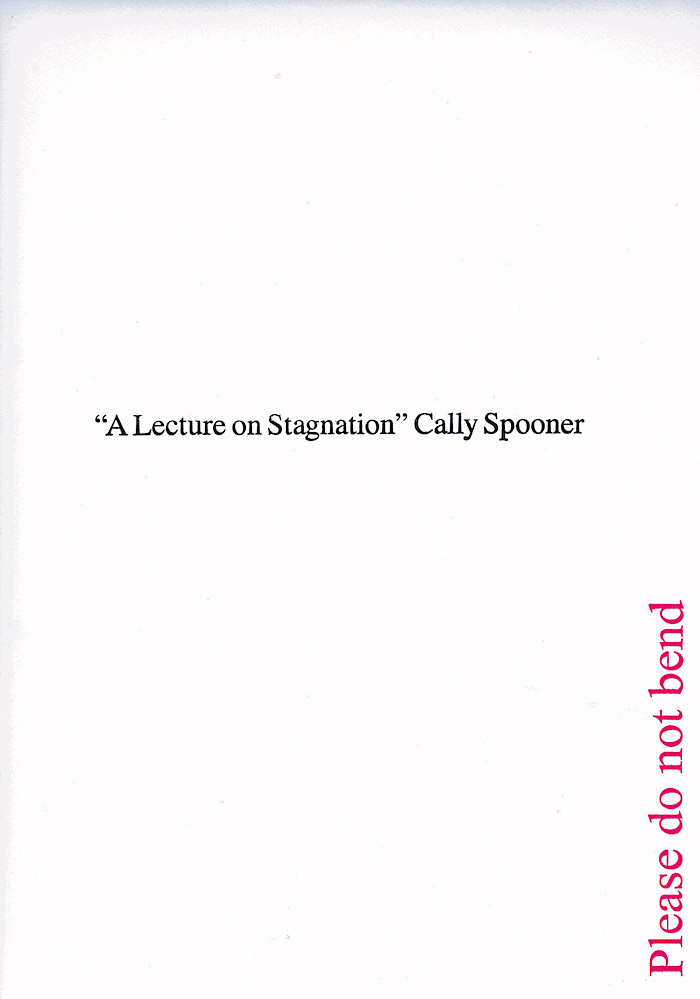
"A Lecture on Stagnation"
It is less a lecture, more like a cartography.
Parts may or may not sync up, we will see.
Ce qui suit est “Une conférence sur la stagnation”
Il s’agit moins d’une conférence que d’une
cartographie. Ses parties peuvent ou non
se synchroniser, nous verrons bien.
Dit is “Een lezing over stagnatie.”
Het is minder een lezing, dan een cartografie.
De onderdelen hiervan kunnen wel of niet
synchroon lopen, we zullen zien.
Trilingual (!) edition. Loose sheets in an envelope. On the same model as Resistance.

The Ideal Lecture
‘This lecture premiered at The Louvre auditorium as part of FIAC’s public programs in October, 2017. To give it, I loaded the talk into a teleprompter program on my laptop. The linebreaks in the piece are a result of the way the teleprompter program broke them up in order to facilitate the reading of the work. Although I have never written lineated verse, I love the idea that a computer lineated the verse for me. This lecture, then, reads an awful lot like the way I talk, but it is truly nothing like the way I talk.’ KG
Kenneth Goldsmith is the author and editor of over twenty books. In 1996, he founded UbuWeb. He teaches writing at The University of Pennsylvania. In May 2011, he was invited to read at President Obama’s ‘A Celebration of American Poetry’ at The White House, where he also held a poetry workshop with First Lady Michelle Obama. In 2013, he was named as the inaugural Poet Laureate of The Museum of Modern Art in New York. His most recent book is ‘Wasting Time on the Internet’, a meditation on digital culture.

Monster Writing
Estefanía Álvarez Ramírez, Keren Kraizer
Project developed in conversation with Mette Edvardsen.
Design by Maria Camila Alfonso.
Published 2020.

Meet Me In The Present: Documents and their Afterlives
Alex Quicho, Camilla Brown and 1 more
Meet Me In The Present: Documents and their Afterlives is an anthology of essays which examines the power of collective action. Spanning twenty-one acts of resistance — from letters exchanged between black power activists to the ethos of protest being brought into the Victoria and Albert Museum — and with an afterword by critic Orit Gat, these essays consider what it means to survive against all odds within a changing society. Drawing from the motives and experiences of those who have protected the right to access shared resources, Meet Me in the Present tells the stories of these diverse defenders. The book calls for public spaces, and for ideas to be made public in a time when ‘the commons’ is increasingly under attack.
Edited by Alex Quicho, Camilla Brown, Hatty Nestor, Laura Fava, Sarah Thacker, and Zachary Soudan
Design by Tom Finn and Jake Tollady

Delta — An Ocean Call
Pontus Pettersson, Izabella Borzecka
Delta is a coming together for choreographic and performative work to be shared and exercised, a place for sharing work by doing the work. A container for participatory projects, dancing, exchange and choreographic inquiries. Delta is organised as evening dance classes, artist zines and thematic publications, like this one: On water histories, narratives and practices.
Water both divides and merges, varies and manifests in different kinds of shapes and structures, acquiring different relations with its surroundings. As a transformative material, could one say that water has a different kind of logic, another kind of dance? In this publication, the contributors Bronwyn Bailey-Charteris, Paul Maheke, Axel Andersson, Sindri Runudde, Vibeke Hermanrud, Elly Vadseth, Daniela Bershan, Sabrina Seifried, D.N.A. (Dina El Kaisy Friemuth, Neda Sanai and Anita Beikpour), Every Ocean Hughes, Adham Hafez, Pontus Pettersson, and Alice MacKenzie share their multi-layered practices, writings, memories and scores on water. Inviting you to submerge!
With contributions by: Bronwyn Bailey-Charteris, Paul Maheke, Axel Andersson, Sindri Runudde, Vibeke Hermanrud, Elly Vadseth, Daniela Bershan, Sabrina Seifried, D.N.A. (Dina El Kaisy Friemuth, Neda Sanai and Anita Beikpour), Every Ocean Hughes, Adham Hafez, Pontus Pettersson and Alice MacKenzie.
Bronwyn Bailey-Charteris: First Move, Original Rains: a Score for Sensing the Precipitational
Pontus Pettersson: Dripping from my fingertips
Adham Hafez: To dance about nature?
Daniela Bershan in collaboration with Sabrina Seifried: Mapping OCEAN
Sindri Runudde: Chosen by the barnacles
Vibeke Hermanrud in conversation with Elly Vadseth: Submerged
Axel Andersson: Confessions of a swimmer
D.N.A: Hydrocapsules.love
Paul Mahek:e As the Waters Recall
Alice MacKenzie: I know that smell
Every Ocean Hughes: Ocean
Pontus Pettersson: 100 ways of water
Graphic design by Sara Kaaman
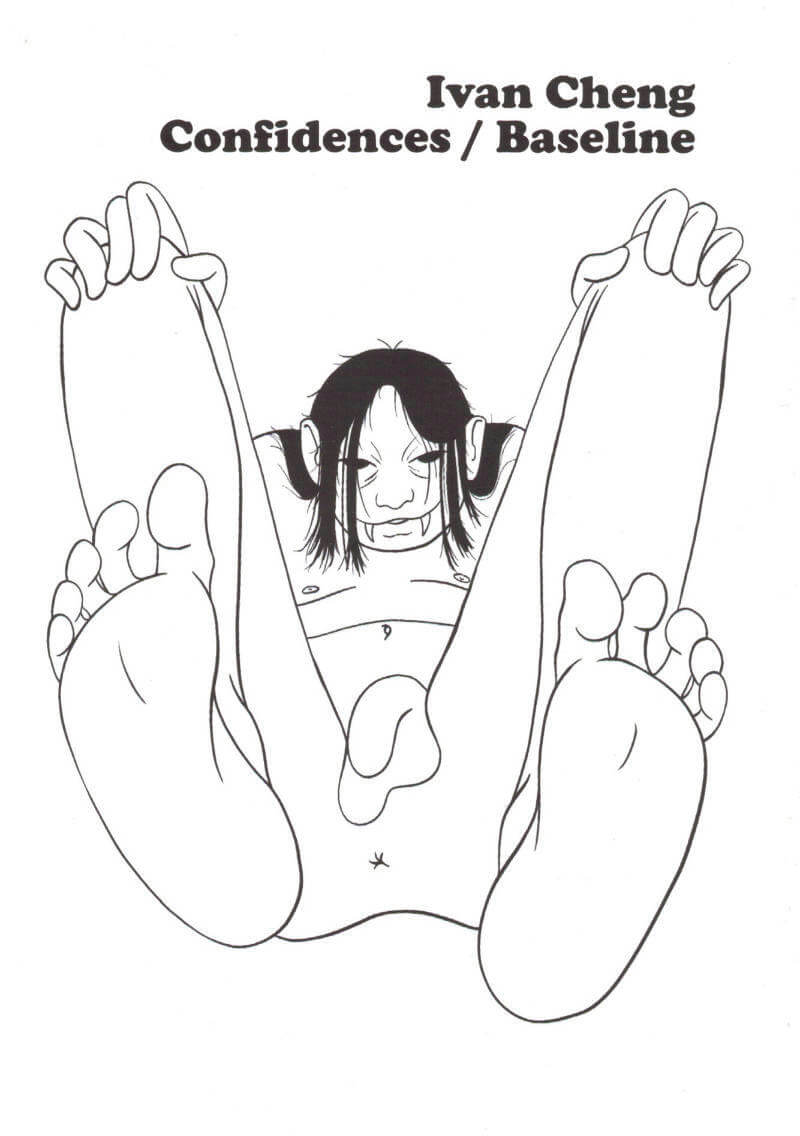
Confidences / Baseline
Confidences / Baseline plays with the vampire novel like a dollhouse. Characters who variously believe in the power of theatre and performance become entangled with grief, desire, and the unknown. What does a rehearsal come to mean when a vampire lives forever?
Baseline is the first in a series of books that fetishise nightclubs for their inaccessibility. Deluded realities anticipate the transformative sensuality of penetration. In his second novel, artist Ivan Cheng maintains his fixation on structures for audiences between public and private.
Designed by Sabo Day
Book cover by Özgür Kar
Back cover photography by Nikola Lamburov
TLTRPreß, Berlin 2021
ISBN: 978-3-9819640-5-9
176 pages, 117 x 164mm, edition of 40,2kg
About Ivan Cheng:
The performances of Ivan Cheng are incomplete, failing, desperate, and riddled with absence. They use his variously trained performing body, incanting texts that foreground subjectivity in monologues and dialogues. Identities of other interlocutors become embedded through rehearsal, dialogue, and entrustment. Without deluded presupposition of being for everyone, Cheng’s practice is invested in questions around publics and accessibility.
In 2020, he reconstituted past performance texts into a murder mystery about a street busker, and continues his foray into written genre with Confidences / Baseline. Past presentations of his texts have occurred at Volksbühne (Berlin), Oude Kerk (Amsterdam), Belvedere21 (Vienna), MuHKA (Antwerp), Nacionalinė dailės galerija (Vilnius), Unsound Festival (Krakow), Carriageworks (Sydney), Federation Square (Melbourne). He holds an MFA in Critical Studies (Sandberg Instituut), having previously studied at the Royal Academy of Music and Sydney Conservatorium of Music.

Errare
ERRARE/WANDERING/WONDERING is a publication by Lucia Palladino that brings together exercises and notes for wild outdoor walking practices in Contemplative Activism. This publication can be used for improvisation and choreographic composition for dancers and actors, but can also be used by everyone as maps for disorientation and deep listening.
Contemplative Activism is an ongoing research in decolonizing, anti-capitalistic practices for the body in relations to the landscape they are immersed in. You find the manifesto of CA inserted in the publication.
Concept and words by Lucia Palladino
Design by Marzia Dalfini
Proofreading by Sarah Cale
Bookbinding by La Rivière Sèche and Lucia Palladino
Co-produced by Nadine for the WAB 2021.

DEARS No. 2 HOPE.FULLY
Robert Steinberger, Delphine Chapuis Schmitz and 1 more
DEARS is a print magazine for transversal writing practices at the crossroads of art, poetry and experimental writing. It brings together authors and writers from different backgrounds and constitutes a dedicated platform for texts escaping the usual genres and disciplinary boundaries.
DEARS promotes the exploration of new forms of language as a way to foster new forms of living together, and emphasizes the growing relevance of trans- versal writing practices in this respect.
DEARS issue no. 2 / HOPE.FULLY / Spring 2021
With texts by Ann Cotten, Barbara Sirieix, Delphine Chapuis Schmitz, Heather Phillipson, Ines Marita Schärer, Kayije Kagame, Legion Seven, Leila Peacock, Louise Guerra Archive, Tarek Lakhrissi, and an epigraph by Rebecca Solnit
Editors are Delphine Chapuis Schmitz, Nicole Bachmann and Robert Steinberger

wild wild Wild West & Haunting of the Seahorse
wild wild Wild West / Haunting of the Seahorse by Jonathan Lyndon Chase, part of a new book series of experimental narratives. This release of non-linear storytelling illustrates black queer bodies moving through fluid states of love, grief, and desire within the canons of science fiction, fantasy and horror. Like a love letter, Jonathan employs multi-sensory entanglements, a blending of the abstract and physical, to draw out complex histories of blackness, meditations on mental health, and queer futurity.
Jonathan Lyndon Chase is an interdisciplinary artist principally working in modes of painting, video and sculpture depicting queer black love and community amid the backdrop of urban and domestic spaces. This is their second book with Capricious Publishing—a debut book Quiet Storm was released in conjunction with Company Gallery in 2018. Chase was born in 1989 in Philadelphia, PA where they currently live and work.

When Carrying Becoming Caring
“In this recent publication (to be printed January 2021) created as a part of my residency at Artist-in-Residence 2020 Petrohradska kolektiv in Prague, I wanted to share a few thoughts on how ‘matter matters’ within artistic practices, but at the same time, it was my attempt to experiment with the ways of presenting research and let the reader trace it as it was evolving – through various forms of notes, readings, writings, and conversations.”
Karolina Rybačiauskaitė (b. 1992) is a researcher currently living between Vilnius and Prague. She studies Ph.D. in Philosophy at Vilnius University, also graduated in History and Theory of Art at Vilnius Academy of Arts. Her research is motivated by the instability of knowledge-making and by searching for the ways to take care of the complex patterns it creates. This involves studying the speculative account of ‘ecology of practices’ proposed by Isabelle Stengers, but also adding to it through various practical engagements with artistic and curatorial reworkings of their matters.
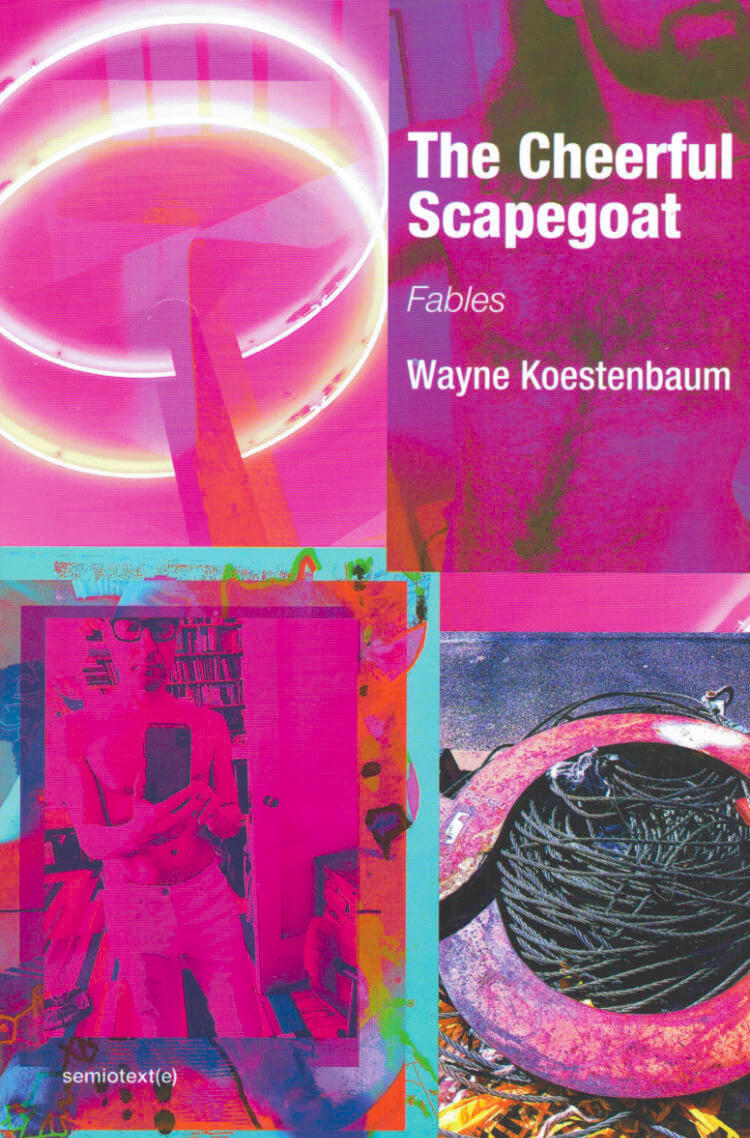
The Cheerful Scapegoat
Wayne Koestenbaum's first book of short fiction: a collection of whimsical, surreal, baroque, ribald, and heartbreaking fables.
In his first book of short fiction—a collection of whimsical, surreal, baroque, ribald, and heartbreaking fables—Wayne Koestenbaum takes the gloom and melancholy of our own terrifying political moment and finds subversive solace by overturning the customary protocols of tale-telling. Characters and narrators wander into strange locales; the difference between action and thinking, between reality and dream, grows moot in a heightened yet burlesque manner. The activities in The Cheerful Scapegoat are a cross between a comedy of manners and a Sadean orgy. Language has its own desires: figures of speech carry an erotic charge that straddles the line between slapstick and vertigo. Punishment hangs over every dialogue—but in the fable-world of The Cheerful Scapegoat, abjection comes with an undertaste of contentment. The tchotchkes of queer culture—codes and signifiers—get scrambled together in these stories and then blown up into an improbable soufflé.
Koestenbaum's fables travel in circles, slipping away from their original point and leading the reader to a paradisiacal suspension of fixed categories. Intensified sentences and curlicue narratives scheme together mesmerically to convince the reader to abandon old ways of thinking and to take on a commitment to the polymorphous, the wandering, the tangential. Koestenbaum's fables—emergency bulletins uttered in a perverse vernacular of syntactic pirouettes—alert us to the necessity of pushing language into new contortions of exactitude and ecstatic excess.
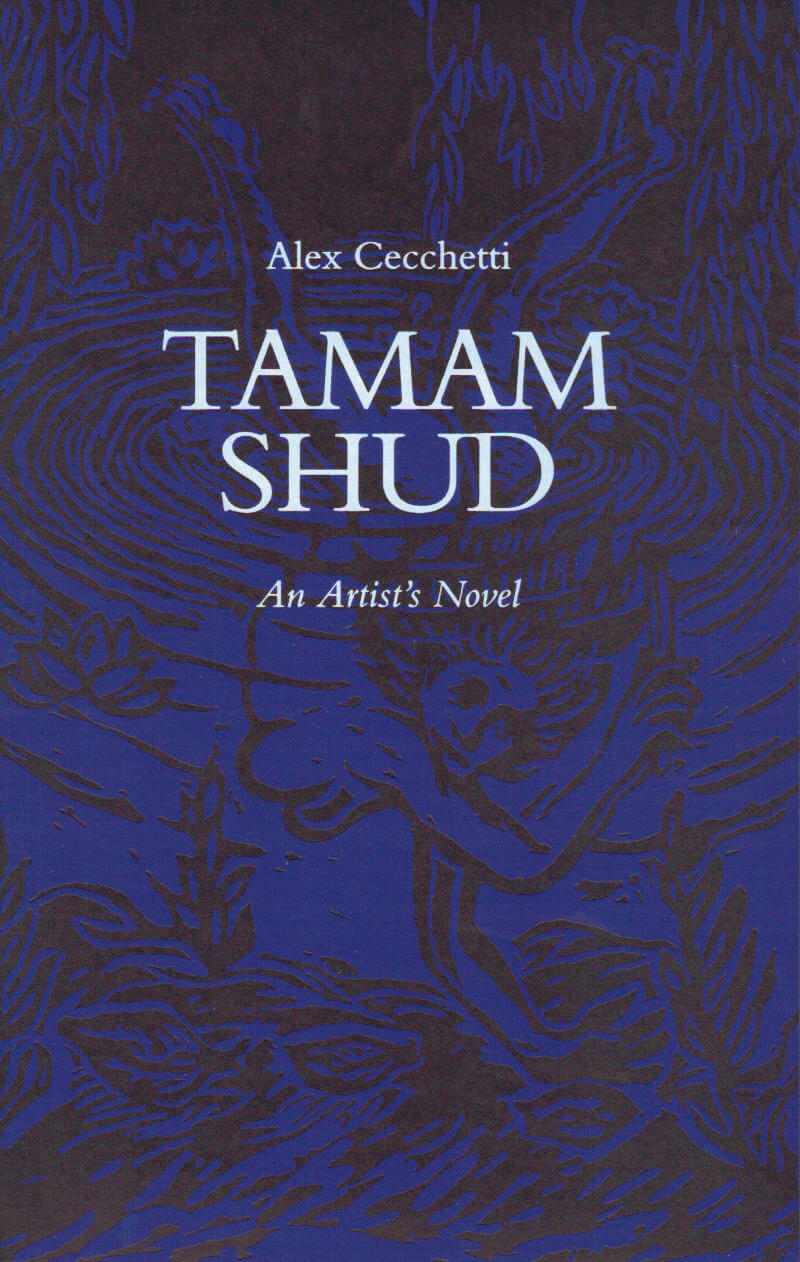
Tamam Shud
A mystery murder artist's novel by Alex Cecchetti, in which the artist and narrator realises he is dead and decides to investigate the causes of his own death.
“I am dead. Homicide, assassination, accident, suicide, the detectives have come up with nothing. The labels in my clothes, my fingerprints, my shoe size, everything has been unstitched, erased, wiped away, blanched, bleached, and consigned to oblivion. As the only clue, in a secret pocket sewn into my trousers, the detectives found a flimsy slip of paper torn from the pages of a book. On that folded bit of paper just two words, Tamam Shud, “this is the end.” Experts, antiquarians, and opium smokers have been consulted, and all agree that these are the last two words in the Rubaiyat, an ancient collection of esoteric poems written by a Persian poet named Omar Khayyam. What the hell do I have to do with poetry, Persia, and hidden pockets? I can't even sew on a button. My identity is still unknown and not even I remember much. This is why I have decided to investigate my own death.”
The Tamam Shud narrative emerged through a series of episodic performances and an exhibition by Alex Cecchetti at the Ujazdowski Castle Centre for Contemporary Art, Warsaw. For two years the writing process and the artistic process were interwoven, feeding each other as they evolved. The art project and the artist's novel are linked together as much as the life of the victim is connected to the piece of paper found in his pocket.
Artist, poet and choreographer, creator of performances and idiosyncratic objects, Alex Cecchetti (born 1977 in Terni, Italy, lives and works in Paris) has developed a unique practice, difficult to classify, that could be called art of avoidance: tactical and poetic, aesthetic and materialistic, its system leads to produce specific situations or objects that can exist both inside and outside the traditional exhibitions. It is in this double movement of representation and conceal that it's possible to inscribe his staging of invisible choreographies of hidden nudes and sleeping dancers. His work is focused in the construction of specific narratives that are experienced both mentally and physically by the audience.

Eine Pinot Grigio, Bitte
A drama in three acts on the main theme of zombies: the most recent novel by the artists' collective.
Eine Pinot Grigio, Bitte is a screenplay that cannot be a film; it is a film that can only be on paper. If the property of a film producer, Bernadette Corporation claims Eine Pinot Grigio, Bitte would be left derelict, abandoned to vagabonds and squatters. It is intended as a narrative of messy revenge, ruined by the screenplay form. With Eine Pinot Grigio, Bitte, Bernadette Corporation asks: How many amateur screenplay writers are there in existence compared to how many amateur novelists? What is the difference between a zombie and an insane cannibal?
Bernadette Corporation is an anonymous artists' group with changing members. From 1995 to 1997, it worked under the guise of an underground fashion label. In 1999 it self-published a magazine, Made in USA, and began producing videos, most notably Get Rid of Yourself (2003). In 2005 Bernadette Corporation authored the much-acclaimed collective novel Reena Spaulings, published by Semiotext(e) and hailed as "[a] sprawling work of crypto-impressionistic fiction that purposefully elides individual authorship for a sort of rarefied mechanical groupthink."
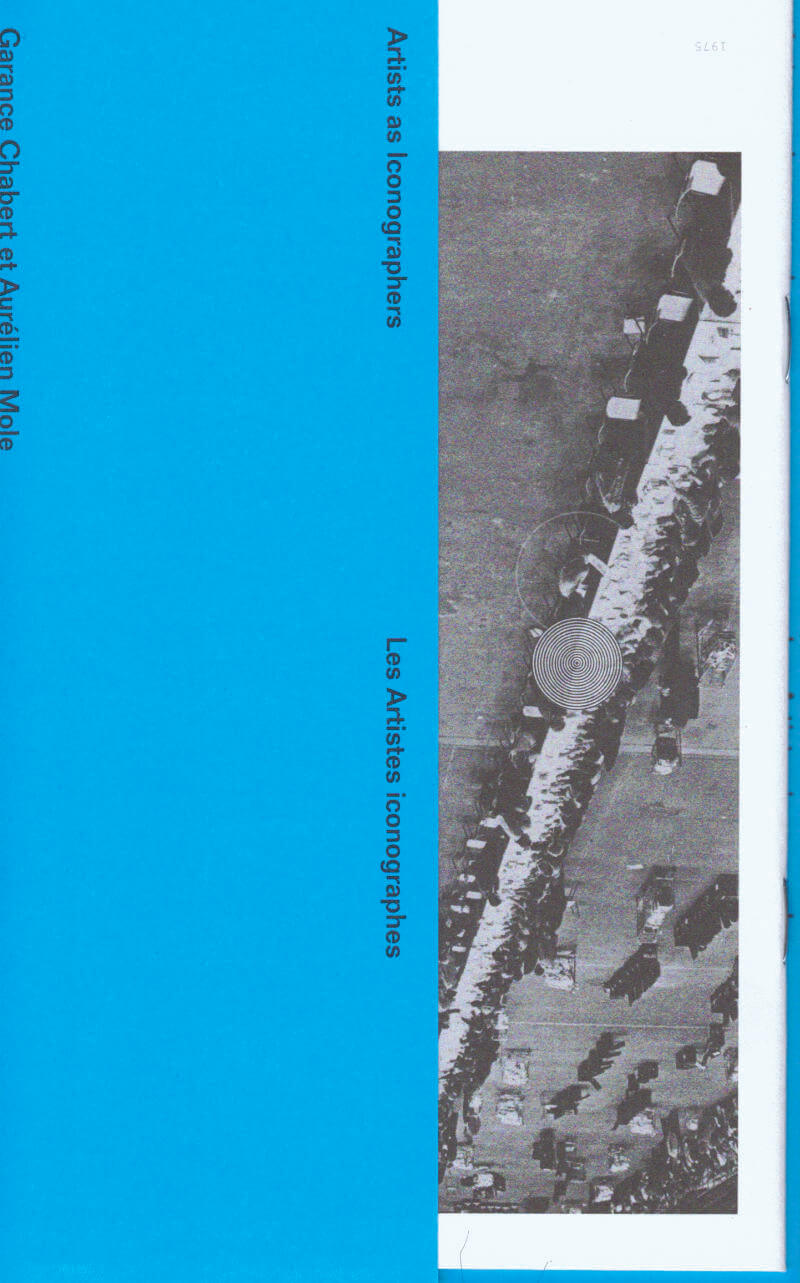
Artists as Iconographers
Aurélien Mole, Garance Chabert
For over a century now, iconographer artists have fuelled their approach by tapping into the diversity of images produced by othersand spread through society by industrial means. From collage to the post-internet school, from archival installations to Appropriationist quotation and image constellations, the present book puts these art practices into perspective, focusing on the last forty years, an extraordinarily dynamic period that recently witnessed the invention and development of a new way of disseminating information and images, the internet. Through theoretical texts, artists’ interviews, and exhibition practices, the book maps the connections artists maintain with images and examines emotion as the driving force in our interactions with them.
Editors: Garance Chabert & Aurélien Mole
Texts: François Aubart, Garance Chabert & Aurélien Mole, Ingrid Luquet-Gad, Jan Verwoert.
Interviews: Pierre-Olivier Arnaud, Barbara Breitenfellner, Céline Duval, Haris Epaminonda, Aurélien Froment, Wade Guyton, Camille Henrot, Thomas Hirschhorn, Pierre Leguillon, Jonathan Monk, Clément Rodzielski, Linder Sterling, John Stezaker, Oriol Vilanova, by Timothée Chaillou.
32 pages leaflet, Turmoil, Batia Suter, 2020, layered reproductions excerpt from a series in progress, various size. Courtesy of Batia Suter.

Fugues
FUGUES is a study of objects. Elements repeat and imitate one another like a polyphonic canon of voices narrating stories of domestic confinement in looped time.
With images by photographer Nicole Maria Winkler & texts by artist Issy Wood, writer Ella Plevin, model Freja Beha Erichsen and curator Elaine Tam.